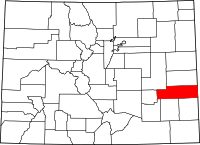Chivington, Colorado
| Chivington, Colorado | |
|---|---|
| unincorporated community | |
|
Chivington in 2015. | |
 Chivington, Colorado Location within the state of Colorado | |
| Coordinates: 38°26′12″N 102°32′32″W / 38.43667°N 102.54222°WCoordinates: 38°26′12″N 102°32′32″W / 38.43667°N 102.54222°W | |
| Country |
|
| State |
|
| County | Kiowa County[1] |
| Government | |
| • Type | unincorporated community |
| Elevation[1] | 3,891 ft (1,186 m) |
| Time zone | MST (UTC-7) |
| • Summer (DST) | MDT (UTC-6) |
| ZIP Code | Eads CO 81036[2] |
Chivington is an unincorporated community in Kiowa County, Colorado, United States. The U.S. Post Office at Eads (ZIP Code 81036) now serves Chivington postal addresses.[2]
Chivington was named for the Reverend/Colonel John Chivington,[3] a Union colonel who was celebrated as the hero of the 1862 Battle of Glorieta Pass and commanded the 700 Union soldiers who perpetrated the Sand Creek massacre, a slaughter of Native Americans in a nearby gulch during the American Civil War. The massacre was condemned by the United States Congress Joint Committee on the Conduct of the War and Territorial Governor John Evans lost his job for encouraging Chivington.[4]
History
Chivington (est. 1887) was one of several railroad towns in Kiowa County on eastern Colorado's plains along the Missouri Pacific Railroad line, and in the late 19th century, eastern Colorado had a lot of agriculture and related commerce. Railroad workers also briefly contributed to the local economy as the Missouri Pacific extended into Colorado Springs, Pueblo, Palmer Lake, and eventually brought service into Denver.
As new towns along this railroad line formed, they were named alphabetically, which might explain why "Chivington" was chosen—with the massacre site only about 9 miles away, "C" brought the name "Chivington" to mind. And in Colorado, the massacre was not as infamous as in the rest of the nation.
During Chivington's early days, it supported a number of local businesses, the crown jewel being the $10,000, 60-room, 3-story Queen Anne styled Kingdon Hotel—but when the railroad realized that Chivington's water had too high an alkali content to use in the locomotive boilers, a nearby town in Kansas (Horace) instead became an important watering stop for the railroad. The Kingdon Hotel was disassembled (its intended purpose was to house railroad workers), and its materials shipped to two other Colorado communities for constructing buildings there—a common fate in Colorado, in the era.
The dust bowl and Depression days of the 1920s and 1930s proved sustained agriculture on Colorado's eastern plains unsupportable, and Chivington (like many other nearby towns) mostly died somewhere in those decades.
Today's Chivington
A few newer homes are still occupied in Chivington, but the town consists mostly of a few abandoned but still-standing ruins, more partially collapsed buildings (the former school house degrades, year-by-year), and many piles of bricks mark where the town once stood.
Standard green highway markers ("Chivington") identify what these ruins once were. The post office existed into the 1980s but nearby Eads today offers the nearest postal service and amenities like stores and gas stations.
Lamar is the closest remaining "significant" town on Colorado's eastern plains. Chivington appears to be returning, like much of eastern Colorado, to its sparse grassland and prairieland origins.
One of the former town's buildings contains a ghost sign asking for Chivington citizens to vote for a man named Jan King, who ran for the office of Kiowa County clerk.
The famous TransAmerica Cycling Trail passes through Chivington and is frequented by hundreds of cyclists annually.
Geography
Chivington is located at 38°26′12″N 102°32′32″W / 38.43667°N 102.54222°W (38.436649,-102.542095).
See also
References
- 1 2 "US Board on Geographic Names". United States Geological Survey. 2007-10-25. Retrieved 2008-01-31.
- 1 2 "ZIP Code Lookup". United States Postal Service. January 3, 2007. Archived from the original (JavaScript/HTML) on September 3, 2007. Retrieved January 3, 2007.
- ↑ Dawson, John Frank (1954). Place names in Colorado: why 700 communities were so named, 150 of Spanish or Indian origin. Denver, CO: The J. Frank Dawson Publishing Co. p. 13.
- ↑ United States Congress Joint Committee on the Conduct of the War, 1865 (testimonies and report). University of Michigan Digital Library Production Service http://quod.lib.umich.edu/cgi/t/text/text-idx?c=moa;idno=ABY3709.0003.001;rgn=full%20text;view=toc;cc=moa. Retrieved 7 June 2016. Missing or empty
|title=(help)
External links
- Chivington, Colorado History
- Modern Photos of Ghost Town Chivington
- Colorado Ghost Town Photography - Chivington, Colorado
- Kiowa County, Colorado History
- September 10, 1982 Kiowa County Press Chivington History page
